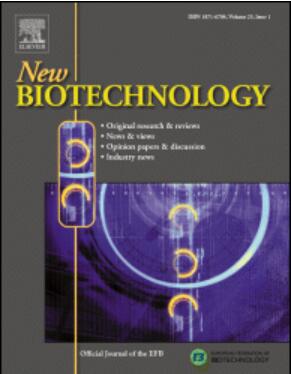Hac1p-based inverse secretory pathway engineering (Hi-SPE) of Pichia pastoris for improved glucose oxidase production
IF 4.9
2区 生物学
Q1 BIOCHEMICAL RESEARCH METHODS
引用次数: 0
Abstract
Secretion and folding are common bottlenecks in protein expression using eukaryotic systems, and engineering the secretory pathway to enhance host cell capabilities is a key strategy for improving protein secretion. However, secretion is a very complex process, making the identification of likely targets for engineering a formidable task. In this study, using glucose oxidase (GOX) expression in Pichia pastoris (Komagataella phaffii) as a model, we introduce a strategy called Hac1p-based inverse secretory pathway engineering (Hi-SPE). This strategy leverages Hac1p, the actuator of the unfolded protein response, which is a naturally evolved mechanism to cope with protein overload in endoplasmic reticulum (ER) of eukaryotic cells. When combined with comparative transcriptomics, Hi-SPE narrows down the target from several hundred genes in traditional approaches to 20 secretion-related protein genes. Results showed that overexpression of six out of seven selected genes improved GOX secretion, including the co-chaperone, JEM1, which increased GOX expression per OD600 by 147.6 %. Further optimization through combinatorial expression of secretion-related proteins led to a strain co-expressing JEM1, KAR2, and CNE1, achieving a GOX titer of 1903.2 U/mL in 1-L fed-batch fermentation. Additionally, transcriptomic analysis revealed the physiological effects of JEM1 overexpression on P. pastoris. This study highlights Hi-SPE as a powerful strategy for improving protein secretion in eukaryotic systems.
基于hac1p的毕赤酵母反分泌途径工程(Hi-SPE)提高葡萄糖氧化酶产量。
分泌和折叠是真核系统蛋白质表达的常见瓶颈,设计分泌途径以增强宿主细胞的能力是改善蛋白质分泌的关键策略。然而,分泌是一个非常复杂的过程,使得确定可能的工程目标是一项艰巨的任务。本研究以毕赤酵母(Pichia pastoris, Komagataella phaffii)中葡萄糖氧化酶(GOX)的表达为模型,引入了一种基于hac1p的逆分泌途径工程(Hi-SPE)策略。这种策略利用了Hac1p,即未折叠蛋白反应的促动器,这是一种自然进化的机制,用于应对真核细胞内质网(ER)中的蛋白质过载。当与比较转录组学相结合时,Hi-SPE将传统方法中的几百个基因缩小到20个与分泌相关的蛋白质基因。结果显示,7个选定基因中有6个基因的过表达改善了GOX的分泌,包括共同伴侣蛋白JEM1,它使每OD600的GOX表达增加了147.6%。通过组合表达分泌相关蛋白进一步优化,菌株共表达JEM1、KAR2和CNE1,在1-L补料分批发酵中获得了1903.2U/mL的GOX滴度。此外,转录组学分析揭示了JEM1过表达对巴斯德酵母的生理影响。本研究强调了高固相萃取是一种改善真核生物系统中蛋白质分泌的有效策略。
本文章由计算机程序翻译,如有差异,请以英文原文为准。
求助全文
约1分钟内获得全文
求助全文
来源期刊

New biotechnology
生物-生化研究方法
CiteScore
11.40
自引率
1.90%
发文量
77
审稿时长
1 months
期刊介绍:
New Biotechnology is the official journal of the European Federation of Biotechnology (EFB) and is published bimonthly. It covers both the science of biotechnology and its surrounding political, business and financial milieu. The journal publishes peer-reviewed basic research papers, authoritative reviews, feature articles and opinions in all areas of biotechnology. It reflects the full diversity of current biotechnology science, particularly those advances in research and practice that open opportunities for exploitation of knowledge, commercially or otherwise, together with news, discussion and comment on broader issues of general interest and concern. The outlook is fully international.
The scope of the journal includes the research, industrial and commercial aspects of biotechnology, in areas such as: Healthcare and Pharmaceuticals; Food and Agriculture; Biofuels; Genetic Engineering and Molecular Biology; Genomics and Synthetic Biology; Nanotechnology; Environment and Biodiversity; Biocatalysis; Bioremediation; Process engineering.
 求助内容:
求助内容: 应助结果提醒方式:
应助结果提醒方式:


